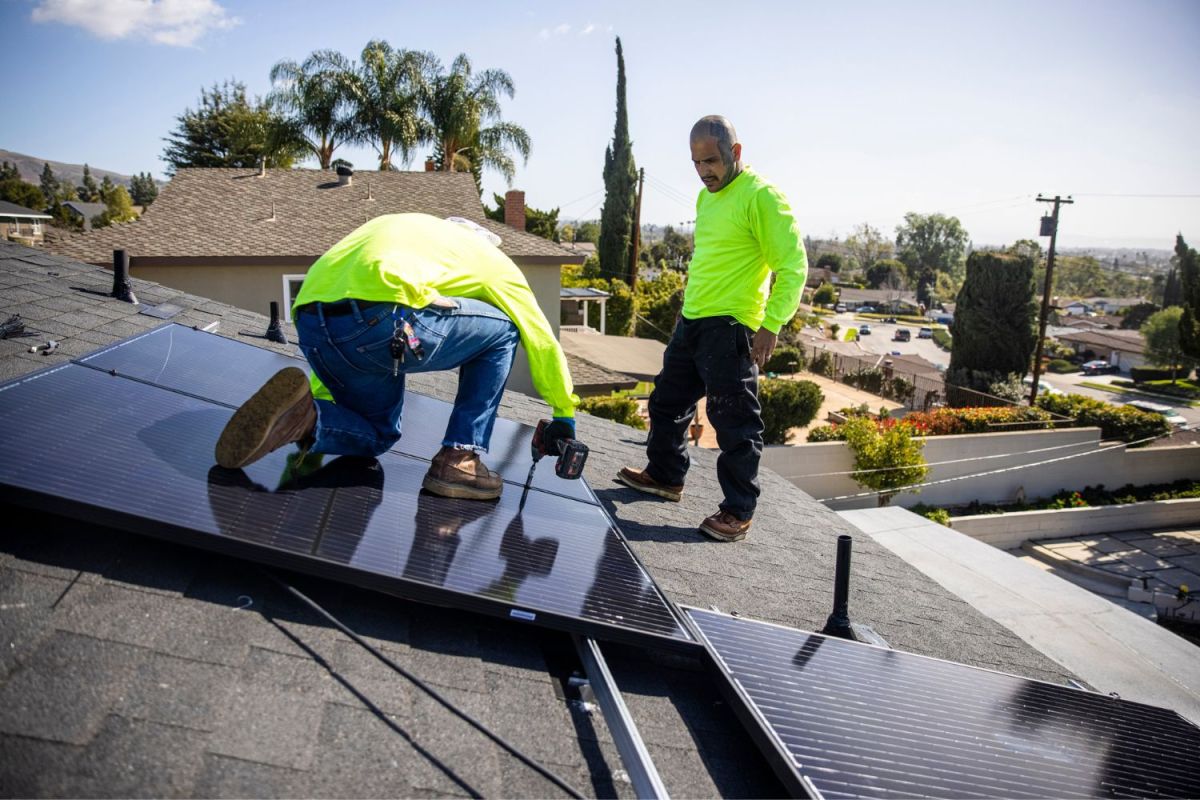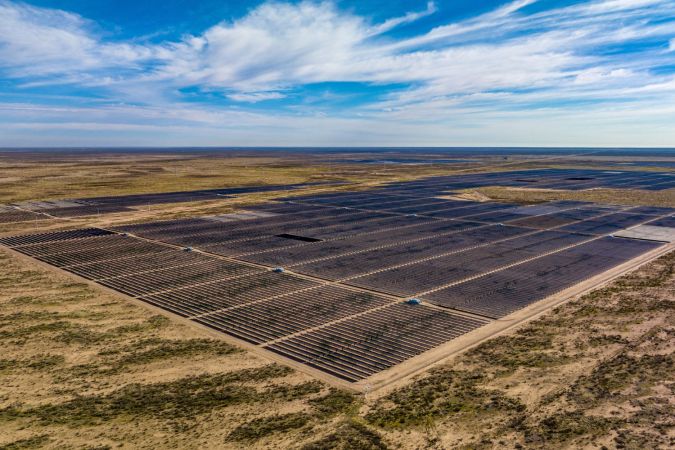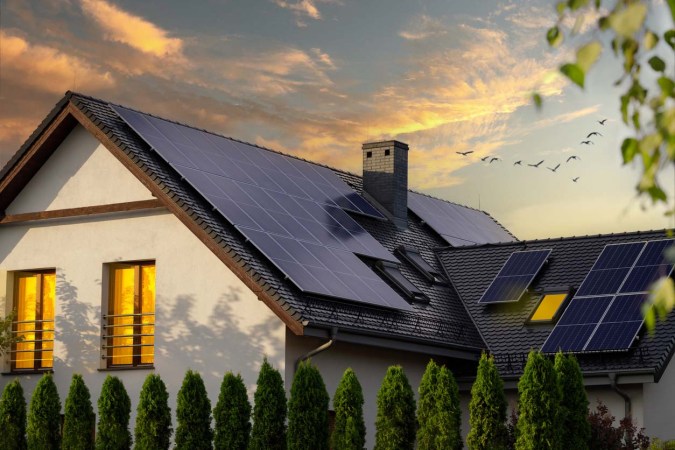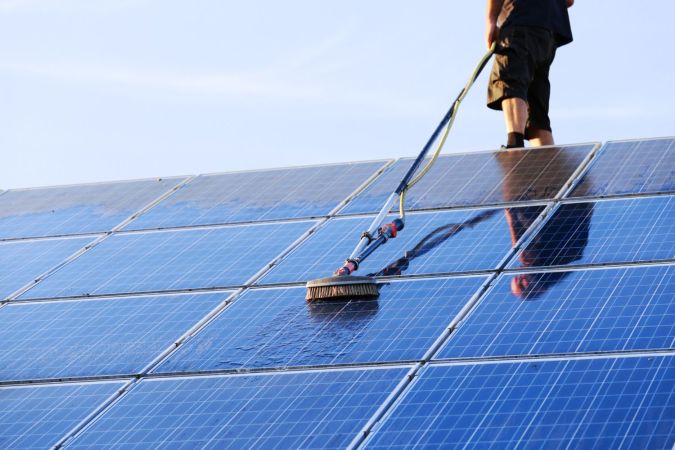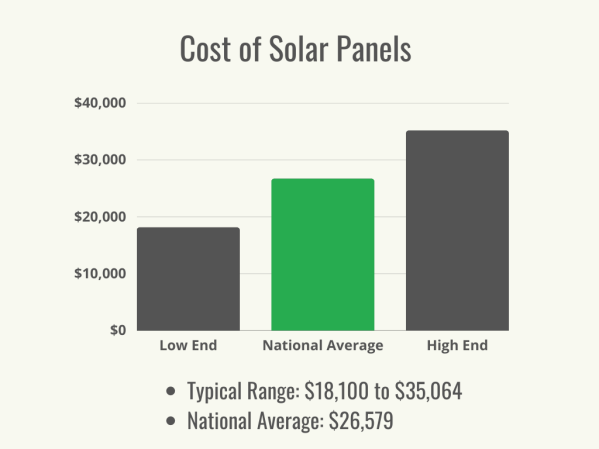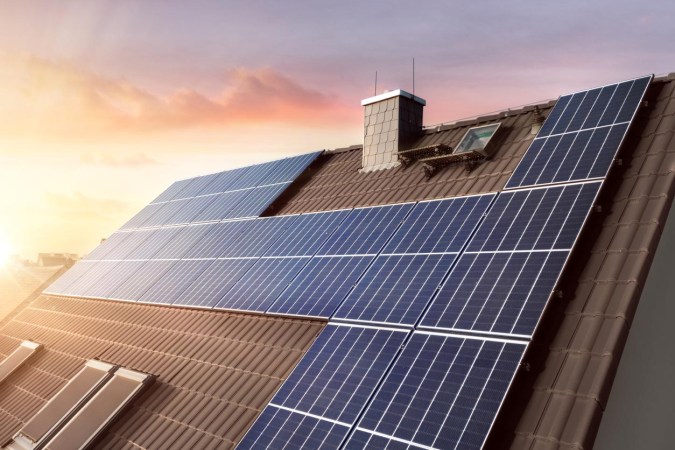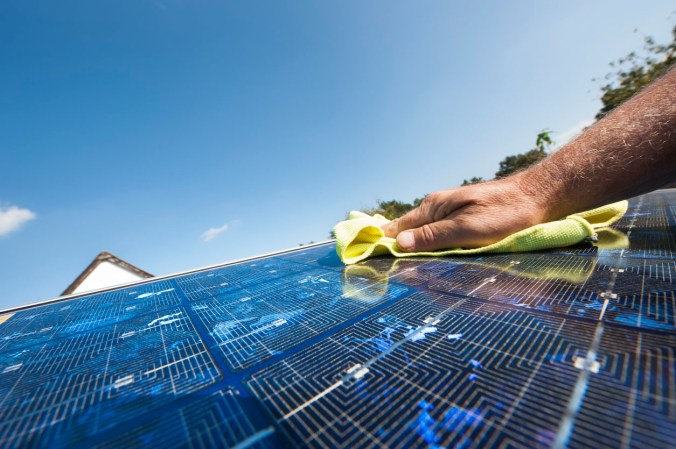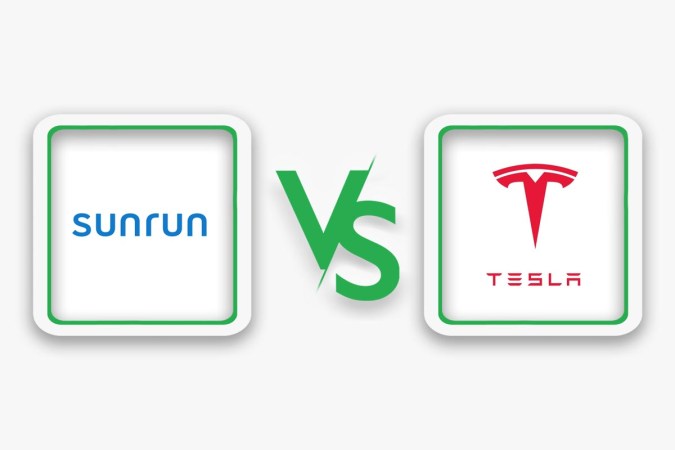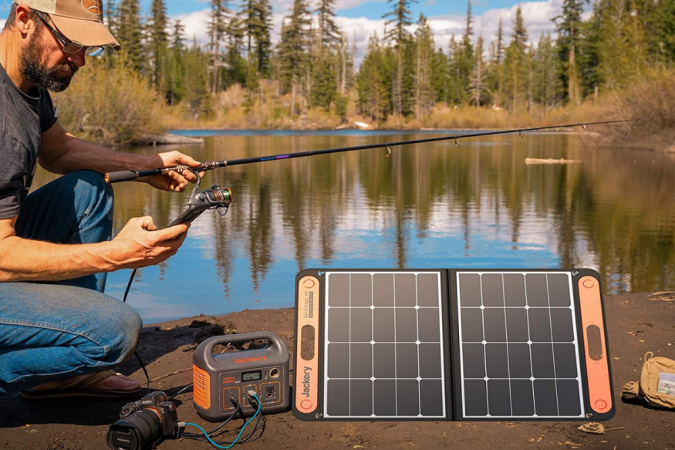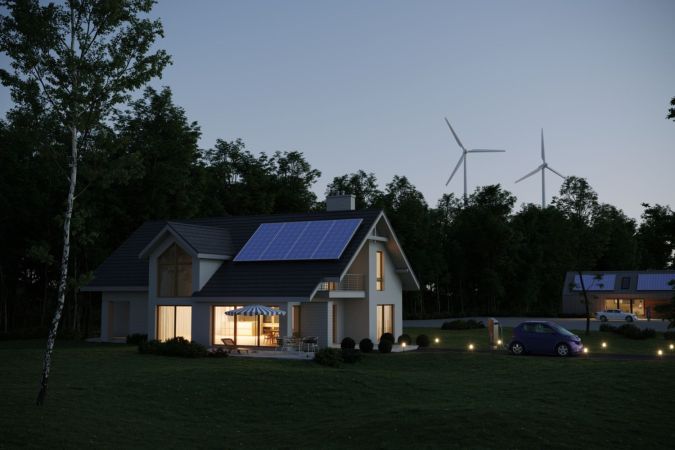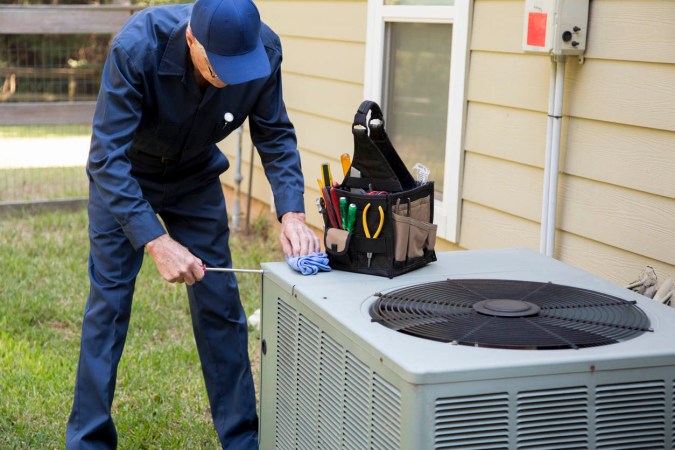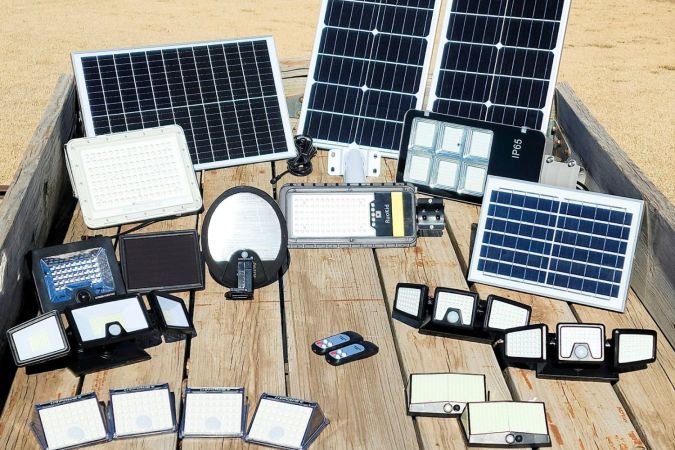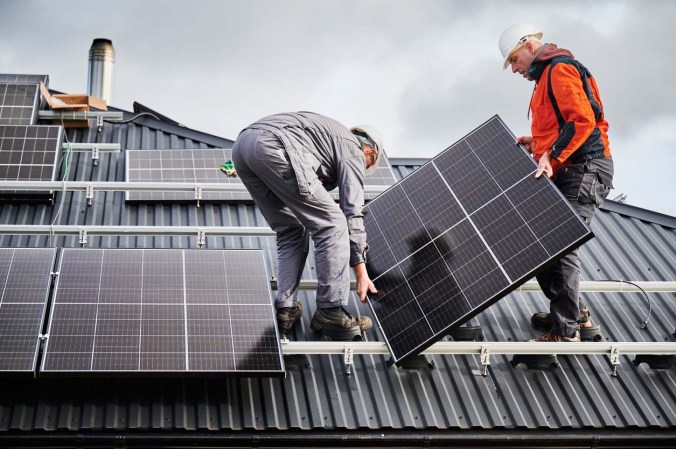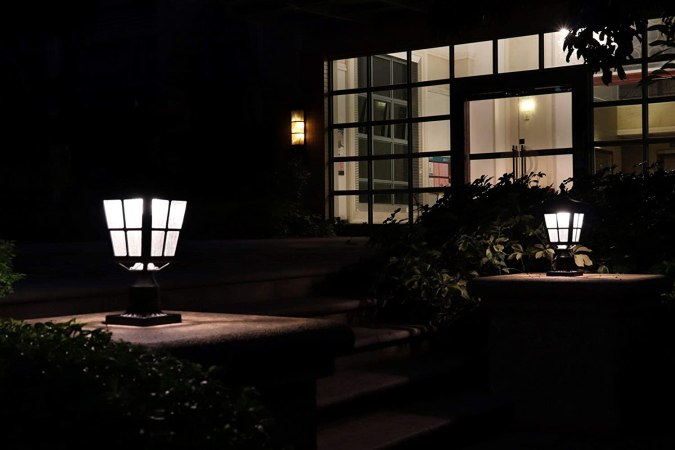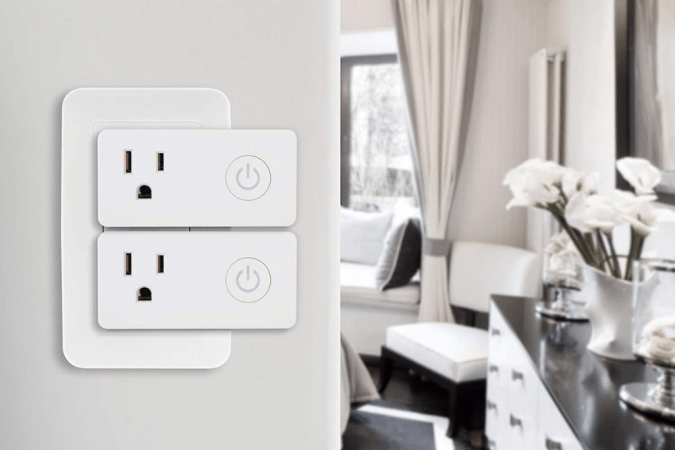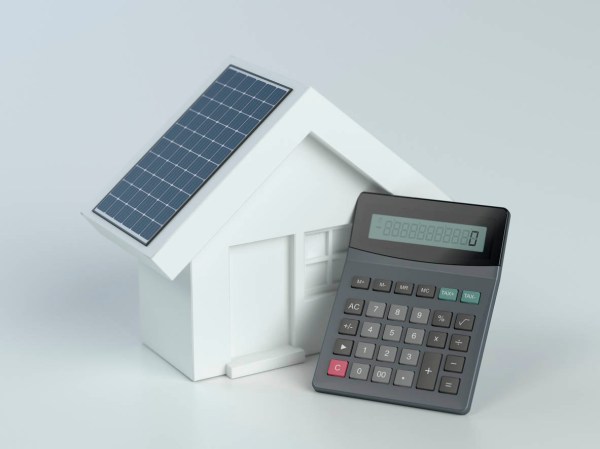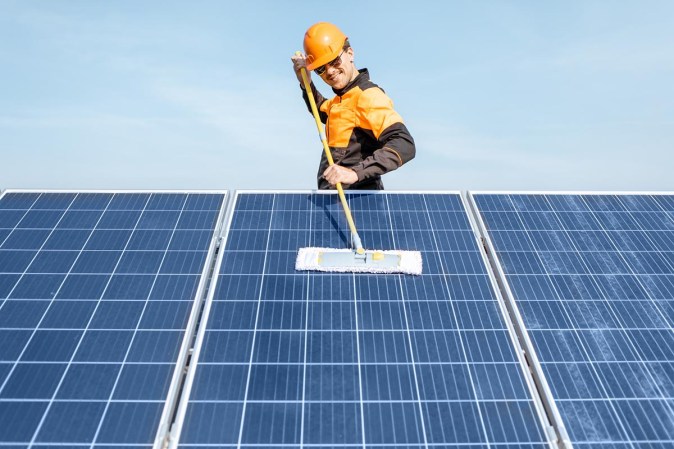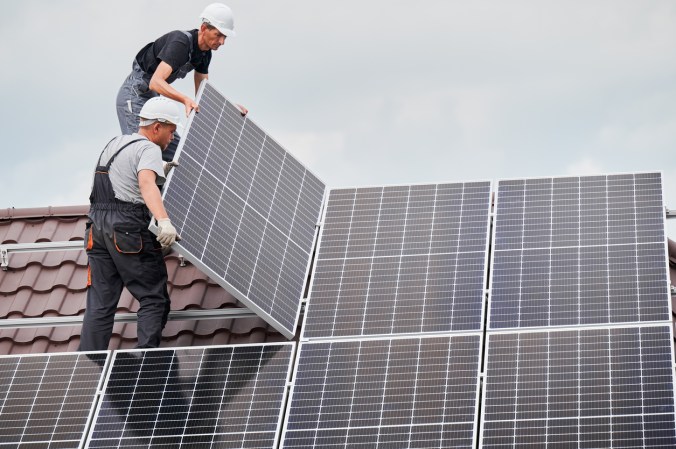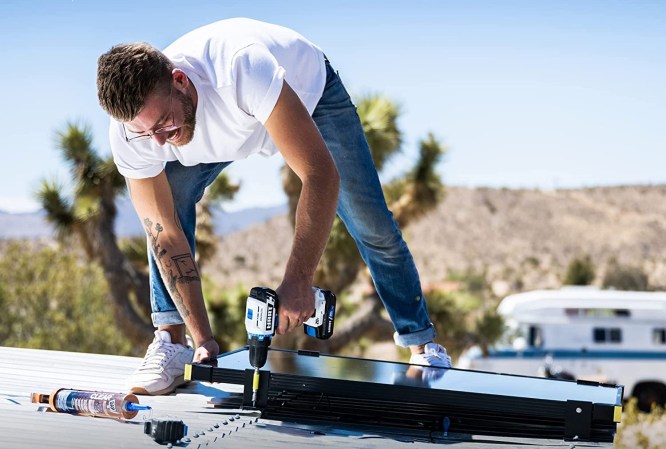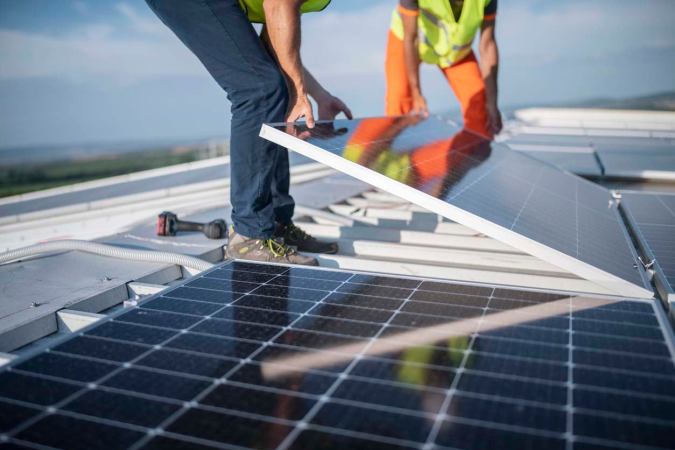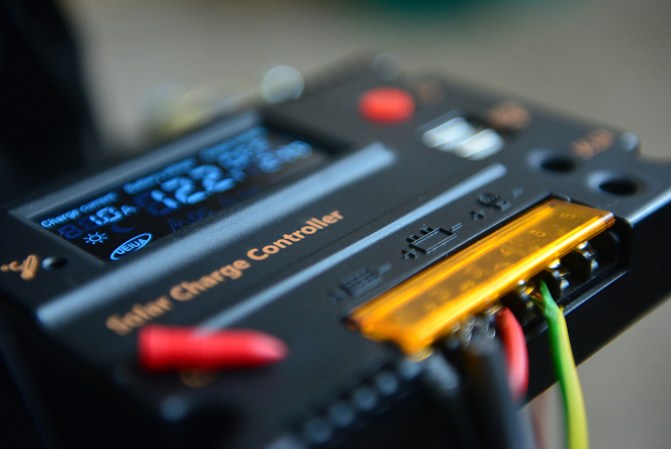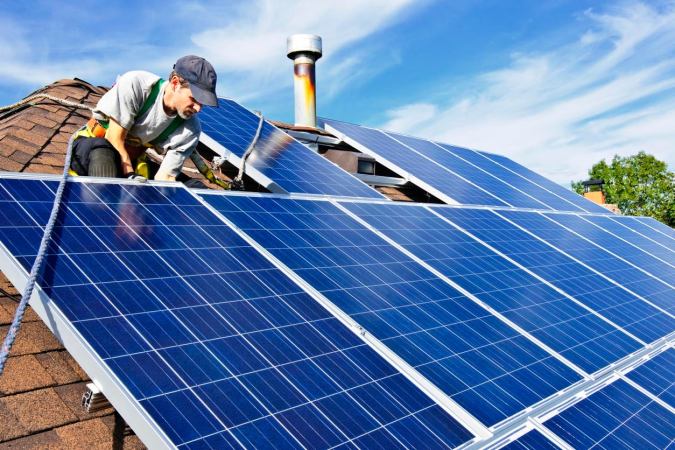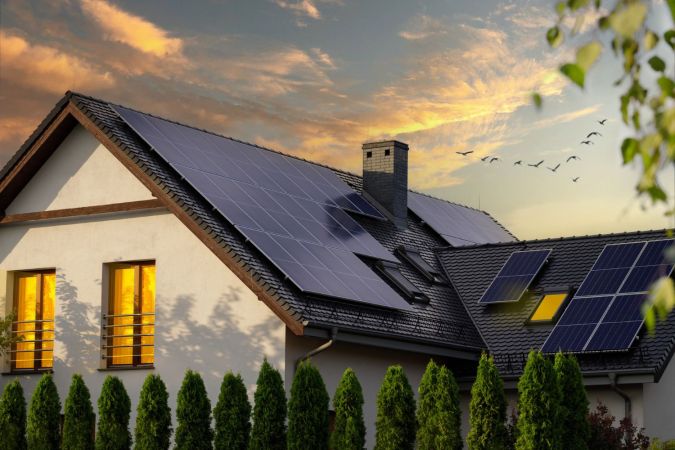We may earn revenue from the products available on this page and participate in affiliate programs. Learn More ›
Highlights
- The typical solar panel cost in California averages $14,873, but homeowners may spend between $12,622 and $17,130.
- Homeowners planning their solar panel budget will need to consider the size and type of system, the brand, labor costs, permits, roof pitch, purchase method, and other factors.
- Some of the primary benefits of installing solar panels in California are a decrease in energy costs with increased energy independence, reduced carbon footprint, and increased home value.
- While DIY installation isn’t prohibited by law, most homeowners prefer to leave the tricky job of installing electrical wiring and panels on a steep roof to trained installers who also know how to obtain the right permits.
Solar electricity is one of the best options for eco-friendly energy since roof solar panels absorb the energy from the sun and convert it into usable electricity for the home. This upgrade doesn’t just positively impact the environment; it can also lower the cost of utility bills for the household. In areas with plenty of sunny days, those solar energy savings make a home solar system a great investment for the environment and the homeowner’s wallet.
“The economic feasibility differs by state due to various factors like local incentives, local energy rates, net metering rules, and weather,” says Will White, a solar application specialist with more than 15 years of experience in the solar industry, currently with Fluke Corporation, a global manufacturer of test and measurement instruments. “California has been a frontrunner in its incentives for homeowners who install solar.”
Solar panel installation costs in California run between $12,622 to $17,130, though the average is about $14,873. The cost of this project can vary depending on several factors. This can include the way in which the system is purchased, the system size, or even the labor involved with the project. Homeowners are encouraged to find out more about the solar panel cost in California and how these factors can affect the overall budget.
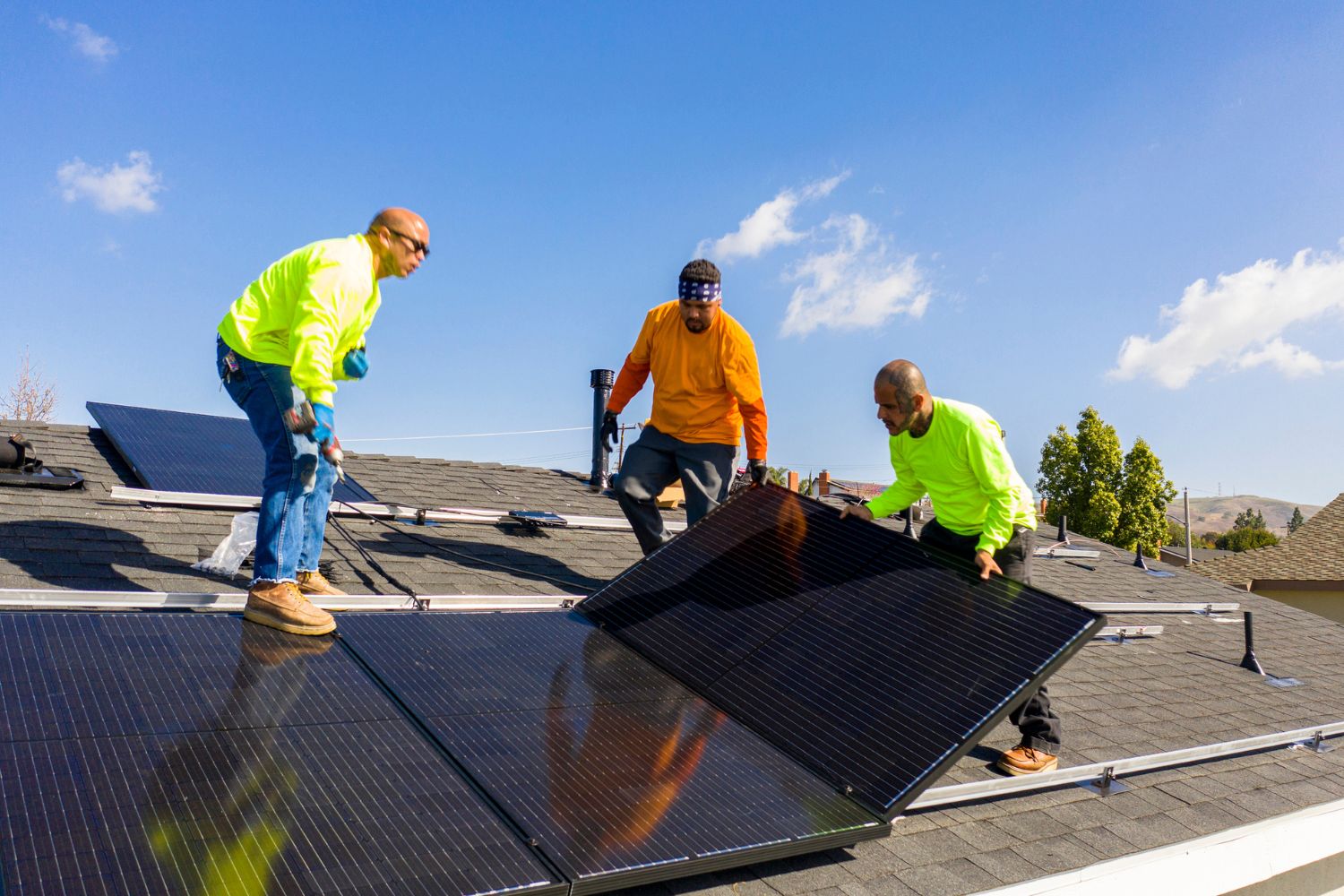
Factors in Calculating Solar Panel Cost in California
There are a range of cost considerations involved in a solar panel installation project, including the system size, purchase method, panel type, roof condition, labor costs, permit fees, and more.
System Size
When calculating the cost of electric solar panels in California, it’s necessary for homeowners to consider what size system the home requires to keep up with electrical demands. “Homeowners’ energy needs can range greatly—from simply wanting to mitigate their carbon footprint and slightly lower their monthly energy bills to wanting to power their whole home with clean energy generated on-site from their solar panels,” explains White. “Your energy needs are a determining factor in the size and design of your solar project.”
The more solar panels required, the higher the overall solar power cost. Most homes in California use about 7,000 kilowatt hours (kWh) per year and require a 5 kilowatt (kW) system, which costs an average of $14,850 to $14,896 to purchase and have professionally installed. However, this is a rough estimate, so homeowners are advised to speak with a professional solar installer in their local area for a more accurate estimate.
| System Size | Average Cost (Materials and Labor) |
| 3 kW | $8,910 to $8,938 |
| 4 kW | $11,880 to $11,917 |
| 5 kW | $14,850 to $14,896 |
| 6 kW | $17,820 to $17,875 |
| 7 kW | $20,790 to $20,855 |
| 8 kW | $23,760 to $23,834 |
| 9 kW | $26,730 to $26,813 |
| 10 kW | $29,700 to $29,792 |
Purchase Method
There are several ways a homeowner can pay for a solar panel system. The cost of the installation can vary depending on the purchase method, so it’s a good idea for homeowners to look into the various options before deciding to invest in the best solar panels for home use.
An outright purchase allows the homeowner to pay for the solar system equipment and installation immediately, instead of having lingering payments with interest accrual for several years. However, this may not be a financial option for some individuals. In that case, homeowners can look into home equity loans or cash-out refinancing, both of which borrow against the value of the home.
Alternatively, homeowners may choose to pay a recurring fee to essentially rent the system with a lease agreement or a power purchase agreement (PPA). However, most homeowners who want a residential solar panel system will work with their bank to get the right type of home improvement loan that can be paid off over several years.
Panel Type, Brand, and Quality
The efficiency of the solar panel system depends on the type, brand, and quality of the solar panel equipment. Typically, premium brands will be more expensive than lesser-known brands, despite having similar products, so it’s worth homeowners’ time to research brands to determine if the solar panel equipment is good quality and the right type for their roof. For instance, solar shingles cost between $35,000 and $75,000, though their thinner profile is appealing to many homeowners.
It’s worth noting, however, that even products from the best solar companies in California (such as SunPower and ADT Solar) may vary in price and quality, so it’s necessary for homeowners to compare individual products before investing in a solar system for the home. In addition to brand, the type of materials that make up the solar panel can influence the cost. Speaking with a company representative in their area can help homeowners understand the benefits and drawbacks of each type: monocrystalline, polycrystalline, and thin-film.
- Monocrystalline solar panels cost about $1 to $1.50 per watt, not including labor or installation expenses. This type of solar panel is the most energy efficient, making it a popular choice for homeowners with room in the budget for these premium products.
- Polycrystalline solar panels are the most common option due to the moderate efficiency and relatively affordable price. Homeowners who want a solar system—but don’t want to pay the price for premium monocrystalline solar panels—can invest in polycrystalline solar panels for a reduced rate of $0.70 to $1.00 per watt.
- Thin-film solar panels are the least common type of solar panel for residential homes due to their relatively high cost and low efficiency. Generally, thin-film solar panels are reserved for commercial locations, but if this type of solar panel seems appealing, then homeowners will spend about $1 to $1.50 per watt.
Roof Type, Angle, and Condition
Given that solar panels are installed on top of the roof, it’s necessary to consider the roof type, angle, and the condition of the roof before starting a solar panel installation project in California. According to the Department of Energy, the ideal position for solar panels is at a 15 to 45 degree pitch on a south-facing roof. However, solar panels can still work effectively, even if a roof is not south-facing.
When the installers assess the home, they will need to determine if the roof is safe to work on. Steep roofs can present a challenge for installers, leading to slower installation times and higher labor costs. Additionally, if the roof is weak in some areas, then it may need to be repaired before solar panels can be installed, adding to the overall project cost. Homeowners can reach out to one of the best roofing companies, such as Aspen Contracting and CMR Construction & Roofing, to inquire about the cost to repair a roof.
Labor and Permits
When hiring an individual, a crew, or a solar installation company, the homeowner will need to account for the cost of labor. Generally, the company will be able to provide a basic estimate of the equipment costs, permit fees, and labor costs fairly early in the discovery process. This estimate can also be used to compare several companies if the homeowner is still unsure about which company to hire. On average, California homeowners can expect to pay about $3,600 to $7,200 in labor fees for a 6 kW system.
Building permits are often required for solar panel installation projects. Homeowners will need to contact the local permit office or work with the solar panel installation company to obtain a work permit before proceeding with the solar system installation. In California, the cost of a solar permit is limited to $450 for residential solar panel installation projects that are equal to or less than 15 kW in size.
Installation Company
The best solar companies can be found in California and other states, which can help homeowners evaluate the cost and value of each company. It’s a good idea for homeowners to start with a broad pool of local solar panel installation companies. This provides a better understanding of the general installation process and products offered, as well as a brief look at previously completed solar system projects.
Based on this information, the homeowner can reduce the number of potential companies to those that are a good match and value. Once they have pared down the list of installation companies, they can ask for quotes from each company to directly compare pricing options.
“Many companies offer a wide range of services, including financing, maintenance options, and battery installation,” says White. “Batteries can level up a solar system, allowing homeowners to store the energy generated on their rooftops for use at night when the sun isn’t shining or in the case of a grid outage. Designing and installing a solar system with batteries requires a unique skill set different from installing one with only solar.”
Solar Incentives and Tax Credits
Solar energy is an excellent alternative to gas, oil, and other energy sources that may cause harm to the environment. By equipping the home with solar panels, the homeowner can passively generate electricity without negatively impacting the environment. At the same time, they can sell energy back to the local utility through a net metering program, reducing the cost of utility bills.
In order to support solar panel installation projects, federal, state, and local governments offer a wide variety of incentive programs and tax credit opportunities. California has many such programs that homeowners can review to find one that fits their circumstances.
- Rancho Mirage Energy Authority Rebate Program gives eligible homeowners a $500 rebate after the purchase of a solar system.
- Sacramento Municipal Utility District Rebate Program offers a rebate of up to $300 for eligible customers.
- Net metering programs allow any solar homeowner to receive credits on their utility bills for their extra solar power production. “Recently, California instated new net-metering rules called NEM 3.0, which significantly reduces the financial benefit of exporting excess solar energy back to the utility grid,” explains White. “However, installing a system with batteries can reduce the negative financial impact of this legislation. Net metering can be complex and can affect the economic feasibility of your solar investment, so be sure to ask your local solar installer for more information specific to where you live.”
- DAC-SASH Rebate Program offers rebates to income-eligible single-family homeowners through Pacific Gas and Electric (PG&E), Southern California Edison (SCE), or San Diego Gas and Electric.
- Federal Solar Tax Credit will credit up to 30 percent of the solar system cost toward federal taxes. This is sometimes referred to as the Residential Clean Energy Credit.
Additional Costs and Considerations
After working through the main cost factors, the homeowner will need to consider a few additional costs that could come up during the installation, which could include warranties, local permits, and regulations, as well as the cost and scheduling of an energy audit. Homeowners can work with the installation company and the local utility to address these potential solar panel cost factors.
Energy Audit
Solar panel systems can be stand-alone systems that send the generated energy to the home and store any excess energy in a connected battery. This type of system is ideal for homes in remote areas that may not have an existing connection to the local electric utility. Batteries can also be used as a backup energy source for the home if the power in the neighborhood goes out.
In most cases, the home and the solar panel system will be connected to the local utility. When this connection is made, the electric utility will need to conduct an energy audit to ensure that the system is safe. While the solar panel installation company will usually book the audit, the homeowner is still responsible for the additional cost of this service, which can vary depending on the electric utility. For example, PG&E customers pay a fee of $145, while SCE customers only pay about $94 to connect the system to the local utility.
Warranties
Warranties are important for property owners to consider when purchasing a residential solar panel system since unpredictable weather can damage the solar panel system through airborne debris, hail, or ice. Depending on the warranty, the cost of replacement or repairs to a solar panel system may be fully or partially covered if a severe storm has damaged the panels.
Warranties may be offered by the solar panel equipment manufacturers but can also be available through the solar panel system installation company. Similarly, some installation companies may offer a guarantee on their work. Discussing the possibility of a product warranty and a work guarantee with the solar panel installation company can help homeowners determine which products and brands are best for their home.
Local Regulations
The exact size, type, and placement of solar panels is typically regulated by the California Energy Commission, but other local regulations may exist, so it’s recommended that the property owner speak with the permitting office, the solar panel equipment installation company, and the neighborhood HOA. The permitting office can help the homeowner understand the basic requirements to receive a permit, while the solar panel installation company can provide advice about the number and position of solar panels for the home.
Homeowners associations (HOAs) can often regulate changes to the exterior of a home; however, this isn’t a concern as it pertains to solar panel system installation. Solar panels receive special exemption in the California property code, as it states that HOAs cannot forbid or restrict a property owner from installing solar panels.
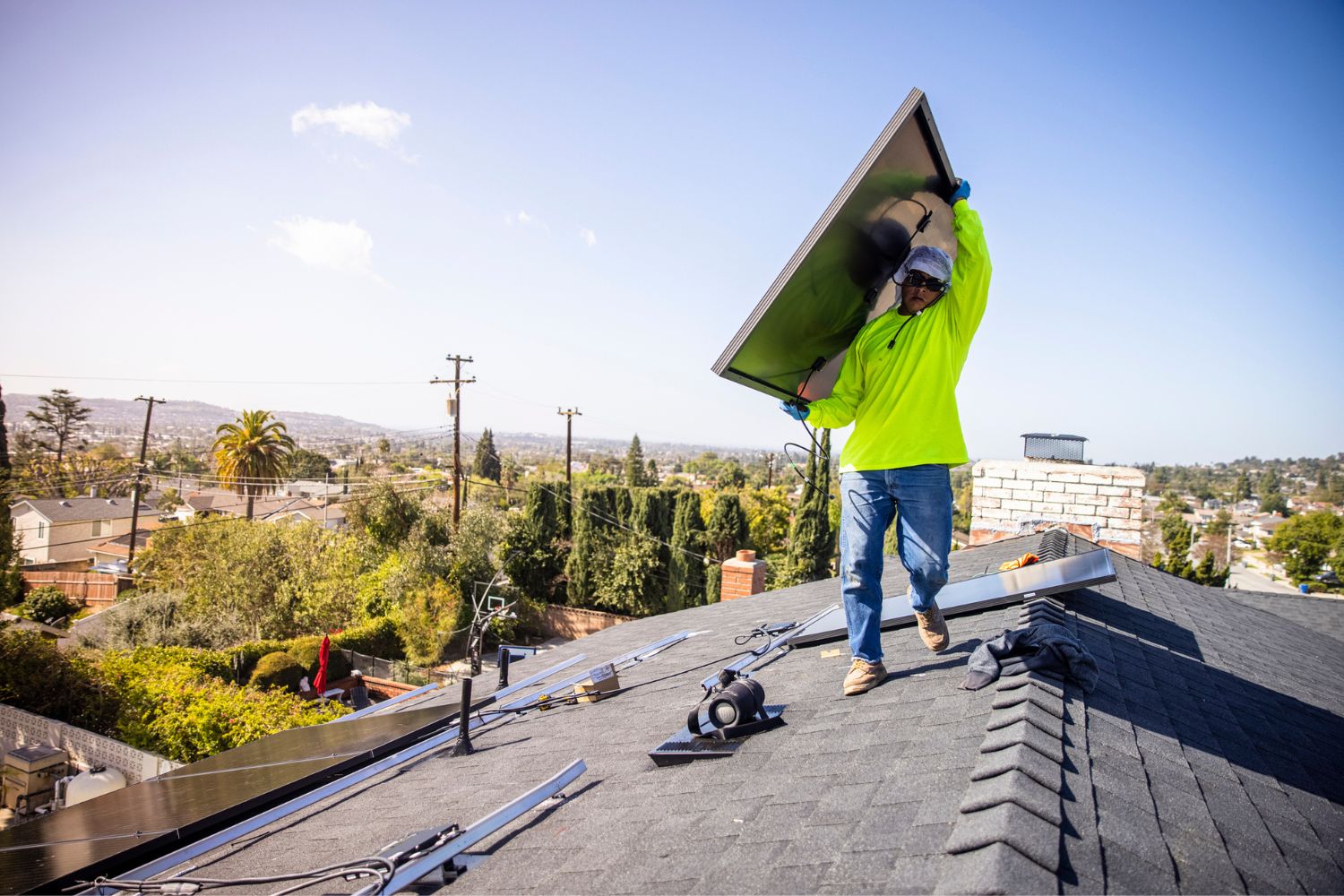
Benefits of Choosing Solar Panels in California
Homeowners who are unsure whether solar panels are a good idea for their home can look into the possible benefits of solar panels. Some advantages of solar energy include decreased energy costs, a reduced carbon footprint, increased property value, and energy independence. California homeowners will want to consider these benefits when deciding if solar energy is right for their household.
Decreased Energy Costs
“Installing solar panels can help homeowners save money on their monthly utility bills,” explains White. The electricity collected by a solar panel system can be stored in batteries for reserve use if the system is not connected to the grid or when no power is being produced at night. It should be noted that an off-grid system will require a substantial battery to store the electricity necessary to operate a full household.
However, if the homeowner connects the solar panel system to the local utility, then the energy can then be sold back to the utility through a net metering program. With this method, the homeowner can reduce the energy costs for the entire household and may be able to recoup some of the up-front costs of the solar panel installation project.
Increased Energy Independence
When a homeowner invests in a solar panel system, it’s common for the solar system to connect to the local electric grid instead of simply storing the energy in private batteries. The reason for this is that the number of batteries, as well as the size of the batteries required to store the energy for an entire household can be cost prohibitive. Due to the high cost of these additions, many people opt to connect the solar panel system to the local utility for backup purposes and use at night.
The solar panel system will connect and provide energy to the local electrical grid during sunny days, and the home will draw energy from the local utility for energy when the solar system is not able to produce enough energy for the household, such as during stormy periods or at night. This means that when the sun is out, the electrical systems throughout the home can receive power directly from the solar panel system, reducing the homeowner’s reliance on the local electric grid and decreasing the annual energy costs.
“Off-grid solar systems are significantly more complicated than grid-connected systems, so installation and maintenance costs are usually higher,” warns White. “The main difference between the two is that an off-grid solar system includes large batteries to store excess solar energy for later use; an on-grid solar system allows homeowners to send excess solar energy generated on their rooftops back to the grid system, and they get rewarded financially for doing so through a process called net-metering.”
Reduced Carbon Footprint
One of the primary advantages for homeowners who invest in solar panels in California is the reduced carbon footprint of the household. “Aside from the financial opportunities, installing solar panels allows homeowners to mitigate their carbon footprint and live more sustainably,” says White. Solar energy is a readily available, renewable resource with limited impact on the environment during use. Many property owners are moving toward more sustainable and eco-friendly resources, so making the switch to solar energy is a good choice to reduce greenhouse gas emissions.
While solar systems deliver clean energy to the home, this does not mean that there is no waste generated by a solar panel system. When it’s time to replace an existing solar panel system or just the solar panels, homeowners have few recycling options, as solar panels are difficult to reuse for more than a few parts.
Increased Home Value
Reduced energy bills and increased energy independence are attractive benefits to installing a solar panel system, but if the homeowner is planning to move, then they may decide to put off this upgrade project. On the other hand, installing a solar panel system can be a good way for homeowners to increase the overall value of the home, depending on the area and the existing prevalence of solar energy systems in the neighborhood.
Before deciding to put in a solar panel system to increase the home value, homeowners can speak to a local real estate professional to determine if this upgrade will have the expected effect on the property value. A list of well-researched solar panel maintenance companies can be given to prospective buyers during an open house or private showing so that they have a better idea of the ongoing maintenance costs of owning a solar panel system.
Solar Panel Installation: DIY vs. Hiring a Professional
Solar panels are designed to soak up the energy from the sun and convert it into usable electricity. To do this efficiently, the solar equipment must be set up in the ideal location for the home. Additionally, the solar panel system will need to be connected to the home and to the local utility. With this in mind, it isn’t recommended for a DIYer to attempt to tackle this project.
“Solar panel installation is a specialized trade that is best suited for trained professionals who have the right skill set and tools to get the job done right,” explains White. “Solar installations, like all construction projects, will fall under all the rules and regulations of the jurisdiction where the project occurs and are subject to being built to local standards like the National Electrical Code or International Residential Code. Professional installers have the experience in their jurisdiction to efficiently and effectively design, install, and commission solar projects that will pass inspections.”
Professionals typically learn through practical training to reduce the risk of personal injury when working at heights. The average DIYer does not have the proper training or equipment to safely work on the roof to install a full solar panel system that safely connects to the power grid. This is also true for homeowners curious about the high cost of Tesla solar roofs since Tesla requires professional installation on its systems.
It’s also necessary for homeowners to understand the complexities of the solar system setup, as well as the factors the installer must assess when planning the project. Generally, installers take into account the type of roof, the slope of the roof, and the current condition of the roof when deciding how to install the solar system for the best results. It’s recommended that homeowners leave this work to trained solar panel installers. These pros do this work for a living and know better than most how to stay safe on the job.
How to Finance Solar Panels in California
Solar energy can be an effective way to reduce ongoing utility costs, though there are long-term payment costs to consider if the system was financed. There are several ways to invest in solar panels for the home, including purchasing them outright; obtaining a loan, a lease, a PPA, or a home equity loan; or by using funds acquired through a cash-out refinancing of the existing home mortgage.
Full Purchase
The cheapest and most straightforward method of purchasing a solar panel system is to simply pay up front for the full cost of the solar equipment, labor, and any associated fees. Taking this route ensures the homeowner that there won’t be any lingering bills to pay years after the installation is completed.
By purchasing the solar panel system outright, the homeowner officially owns the equipment and can apply for solar energy incentives and tax credits related to the installation of the solar panel system.
Loan
Any of the best solar panel loans are a popular method for homeowners to purchase solar panel systems. Homeowners can apply at their bank or look into solar loan providers for project financing options. There may even be some solar panel installation companies that offer solar loans to interested customers as a way of selling their products and services.
In many cases, a homeowner can take out a small loan for a solar panel system installation, then pay off that loan over an average period of 36 months to 21 years. However, homeowners who are unclear about the terms of the loan may want to speak with a financial adviser to review the specific terms and conditions.
Lease
Generally, homeowners can expect a solar lease contract to last for 10 to 20 years. When a solar system is purchased through a lease agreement, the homeowner does not own the solar equipment. With this in mind, a lease can be a good way to invest in a solar panel system if the homeowner isn’t concerned about applying for solar incentives or tax credits.
While the system is installed and the lease is active, the solar system provider is responsible for monitoring the solar system hardware and performance. Typically, the leasing company will charge the homeowner a monthly or annual fee to rent the system. When the lease is up, the company will work with the homeowner to either remove the system or sell it to them.
Power Purchase Agreement
Another method for purchasing a solar panel system without actually owning the solar system is through a power purchase agreement (PPA). This type of financing isn’t always available, so some homeowners will need to research reputable solar panel system providers to find a company that offers PPAs.
A PPA works similar to a lease in that the homeowner does not own the solar panels. Instead, they are essentially renting the solar panel system for a fixed price based on the amount of electricity generated.
Home Equity Loan
Home equity loans are one of the more reliable options when homeowners are considering a solar panel system installation. The best home equity loans have lower interest rates than a traditional loan, reducing the amount the homeowner pays over the loan period. Lenders such as U.S. Bank or Flagstar Bank can discuss with homeowners the possibility of borrowing money against the home’s existing equity.
The home’s value depends on how much of the home is currently paid off, as well as the size, location, and quality of the property. Homeowners can speak to a financial adviser about the possibility of securing a home equity loan to pay for a solar panel system installation. Solar power systems are frequently seen as a good long-term investment and often receive approval if the applicant’s finances are in good standing.
Cash-Out Refinance
Instead of taking out an additional loan on the home, cash-out refinancing allows the homeowner to pay off the entirety of the existing loan, then take out a new loan at a higher value. The bank or the company that holds the loan will then pay the homeowner the difference in cash. If the purpose of the cash-out refinance is to invest in a solar panel system, then the money received can be put toward the purchase.
Another benefit to cash-out refinancing is that it will usually have a lower interest rate than a home equity loan. Homeowners can reach out to some of the best mortgage refinance companies (such as PNC Bank and Caliber Home Loans) for help in assessing their home mortgage and refinancing options.
How to Save Money on Solar Panel Cost in California
Investing in a solar panel system in California is less expensive than in some other states, but that doesn’t mean that it’s cheap. Homeowners will still pay about $14,873 on average for a new system. Before hiring a solar panel installation company, property owners can review several tips for saving money on the cost of solar panels.
- Get multiple quotes. Contacting several reputable companies in the area to get accurate quotes for this project can ensure a fair price and the right value. Some companies may also offer ongoing programs to help reduce the solar panel maintenance cost.
- Select a cheaper system style and size. Solar panels collect energy that can be sold back to the electric utility, regardless of the style or size, so it may be most cost-effective in the long run to choose a smaller solar panel system that fits the budget.
- Look into loans, leases, or other financing plans. Homeowners can reduce the up-front cost of this job by getting a loan from a bank, leasing the system, or working with a financial adviser to take out a home equity loan.
- Save with solar energy tax breaks and incentive programs. California is a popular state for solar energy due to the variety of incentive programs available to state residents and the high rate of daily sunshine. Tax breaks and incentive programs help homeowners save on installation costs.
- Schedule the job for the offseason. While the sun is often shining in California, some areas experience cloudier and cooler weather during the winter months, which can lead to lower installation costs due to lower demand.
Questions to Ask About Solar Panel Installation in California
It’s a good idea for homeowners to learn more about how solar panels are installed before hiring a company to complete the work. Part of that research includes checking the various solar panel products and local solar panel installation companies in the interest of protecting this investment. To learn more about solar panel system components, the costs involved with the project, and the quality of the installation company, homeowners can use this list of questions to ask an installer.
- Are you licensed, bonded, and insured?
- Do you have any available references?
- Can I see a portfolio of past projects?
- Is my home suitable for solar panels?
- What conditions are necessary for a solar system?
- How long will installation take?
- What type of solar panels do you offer?
- Can I get a cost estimate for the project?
- Do you offer any warranties or guarantees?
- What are the long-term savings for installing a solar panel system?
- How will installing solar panels impact my home’s value?
- How does a solar system generate electricity?
- How much power can I generate with solar?
- How long will solar panels last?
- How do you clean solar panels?
- Where will the solar panels be placed?
- How can I find incentives and tax breaks for solar panel installation?
- What are the environmental benefits of solar?
- Will a solar system produce enough energy to handle all my electric needs?
- How will I know if the system is working?
- What happens during an electrical outage if the solar system is connected to the grid?
- Can I add battery back-up?
FAQs
Informed homeowners can make effective decisions that benefit the existing and future state of their home when they have plenty of information at their fingertips. Additional information about solar panels is included with answers to some of the most frequently asked questions.
Q. Is solar in California worth the cost?
Given that Californians have a high rate of annual sunshine and higher-than-average power costs, solar panels are worth the investment for California property owners. Additionally, there are several incentive programs and tax benefits that California residents can take advantage of to lower the cost.
Q. How long do solar panels last?
On average, a solar panel system will last about 25 to 30 years with proper care and regular maintenance, including cleaning and minor repairs. Most homeowners see their initial investment paid off within 6 to 10 years.
Q. How many solar panels are needed to power a house?
Most homes in California use about 7,000 kilowatt hours per year. There is a simple calculation homeowners can complete to find out how many solar panels are needed to power the home.
(Annual kWh Usage / Average Production Output Ratio) / Average Wattage Output per Solar Panel = Number of Panels
Number of panels: 7,000 kWh / 1.3 / 320 W = 16.82
This means that most California homes can be supported with around 17 panels. Solar professionals typically calculate that an average California home can operate sufficiently with a 5 kW system.
Q. Can I install my own solar panels in California?
There are no regulations that prevent a DIYer from installing their own solar panels in California, but the designs and electrical installation plans must comply with all the requirements for setting up a solar power system. In addition, the solar panels must operate to the standards of the local building codes. With this in mind, it’s generally better to hire a professional solar panel system installation company, unless the DIYer has extensive experience working with electrical systems on top of steep roofs.
Sources: EnergySage, Fixr, Greenlancer, MarketWatch, California Public Utilities Commission, Bankrate

